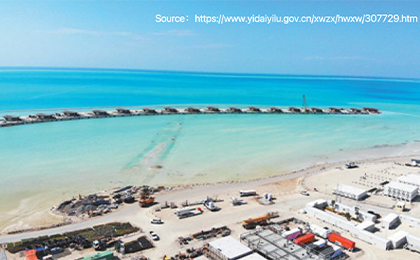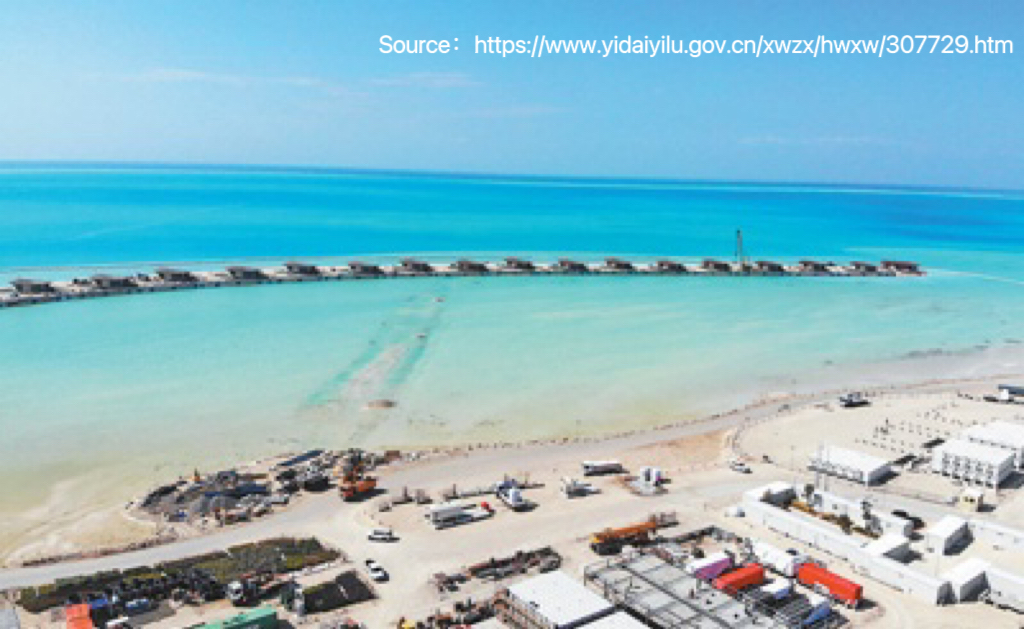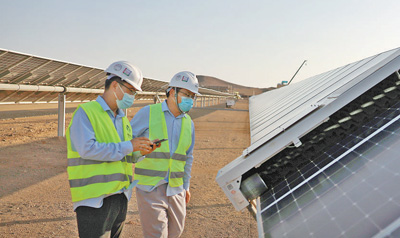



Construction scene of Red Sea New City in Saudi
In recent years, China and Saudi Arabia have made good progress in strategic alignment and cooperation in various fields. China supports Saudi Arabia's major development initiatives, like Vision 2030, Green Middle East,etc., and has taken an active part in Saudi Arabia's industrialization process to help diversify its economy. A green new city is being created on the Red Sea coast under the Saudi Vision 2030 framework. Among them, the Red Sea public infrastructure project contracted by the Third Branch of SEPCO Electric Power Construction Corporation (hereinafter referred to as SEPCO) which is the branch of Power Construction Corporation of China (hereinafter referred to as POWERCHINA) via EPC(Engineering Procurement Construction)is actively contributing to the construction of the new city. A few days ago, this reporter visited the project site by the Red Sea.
Artificial wetland, sewage treatment plant into a new landscape
In the vast desert on the shores of the Red Sea, patches of reeds are lush, and flocks of birds fall from time to time. "The constructed wetland here is our 'sewage treatment plant'." The biological "sewage treatment plant" consists of two reeds and a sedge field, said Mr. Mo Bing, project manager of the Third Branch of SEPCO. After pretreatment, the domestic sewage in the New City of the Red Sea is filtered through the first reed to remove large particles of impurities, and then pumped into the second reed to wait for heavy metals and other substances to be absorbed. Finally, it enters the sedge field under the action of gravity, and then filtered again into the reservoir.
The Red Sea New City project, located in the western Saudi province of Tabuk, covers 28,000 square kilometers and is a key project of Saudi Arabia's Vision 2030, which has been described as a "new generation city". When completed in 2030, the project is expected to receive 1 million domestic and international tourists annually. A highlight of the new city is that in the future its electricity supply will come from 100% clean energy, becoming the world's first large-scale commercial utility project to integrate multi-energy complementary systems and the largest off-grid energy storage project.
The Red Sea New City gets its drinking water from desalination. Some of the desalinated water also serves another function: water cooling air conditioning. The desalinated water passes through a central cooling station, where it is cooled to around 4 degrees Celsius. It is then pumped to the buildings of the Red Sea resort for air heat exchange to regulate the indoor temperature. The electric energy of the central cooling station comes from the photovoltaic power plant supporting the project. Depending on the 40,000 cubic meter cold storage tank built in the cold station, the remaining photovoltaic electric energy in the day can be stored in the form of cold energy, so as to realize continuous cooling at night without consuming additional energy, truly realizing green energy saving and environmental protection.
At present, the first phase of the constructed wetland project built by China has achieved a daily water recycling and treatment capacity of 6,000 cubic meters. When the project is fully completed, the treatment capacity will reach 16,000 cubic meters per day. "The irrigation water for that seedling base comes from here. In the future, the Red Sea New City will need a lot of greenery and irrigation water." Mo Bing said, pointing to a stretch of jungle in the distance.

Chinese workers test an automatic cleaning robot at a photovoltaic power station in Saudi Arabia's Red Sea New City project
Photovoltaic + energy storage to provide green electricity for the city
In the photovoltaic power station site supporting the project, the photovoltaic panels are neatly arranged endless and each row of photovoltaic panels have a rectangular "box" at the top. "This is our automatic cleaning robot." Mo Bing said that the advantage of using photovoltaic power generation in desert areas is sufficient sunshine, but the disadvantage is large wind and dust, which will affect the efficiency of photoelectric conversion. The automatic cleaning robot can periodically clean the dust off the photovoltaic panels. He opens a mobile app, clicks Start, and the robot starts working.
On the other side of the photovoltaic plant are rows of white shipping containers. This is the storage tank provided by Huawei Digital Energy Technology Co., LTD. Some of the storage tanks have been powered on, and the total storage scale of the project is expected to reach 1,300 megawatt hours. There is also a standby internal combustion engine power station next to the site of the energy storage box, which can meet emergency needs in case of bad weather conditions or heavy power consumption and power shortage at night. According to the report, the project has 25 biomass fuel combustion engines, distributed in six different sites, as backup energy to provide green electricity.
The reporter boarded a working cable-laying boat. In the middle of the ship stood an elevated frame, over which cables wound their way slowly toward the stern, before "riding" a slide to the bottom of the sea. Island pipe network regional project manager Mr. Zhao Yunpeng introduced, there is a ship in the distance to cooperate with the operation. From there, autonomous underwater robots launch and smash the seabed along the undersea cables to complete the laying. He says the underwater autonomous robot can operate at depths of 100 meters.
The Red Sea New City project is planned to include 22 tourist islands, each with one or more luxury hotels and resorts. A network of more than 10, 000 kilometers of cable lines can deliver electricity to all parts of these islands and the New City.
Strengthen cooperation and jointly explore energy transformation
The green and intelligent construction of the Red Sea New City project has received positive comments from media and industry insiders in Saudi Arabia and other Arab countries. Ken Larson, CEO of the Red Sea Tourism Project of ACWA Power, said that there are 18 EPC subcontractors in the whole project, and the Third Branch of SEPCO ranked first in comprehensive score, having achieved 17.42 million safe working hours, showing a good image of Chinese enterprises.
Mr. Zhu Jing, country representative of POWERCHINA in Saudi Arabia, said that Saudi Arabia is committed to green, low-carbon and sustainable tourism projects in the Red Sea and to green and pollution-free energy supply. China has proposed a "dual-carbon" goal, and Saudi Arabia has launched the "Green Saudi Arabia" initiative. Low-carbon projects have become a key area in the Belt and Road cooperation between China and Saudi Arabia. POWERCHINA will give full play to its advantages and strengthen green cooperation with Saudi Arabia.
Mohammad Abunayyan, chairman of the ACWA Power, said that China is developing rapidly in the field of new energy and making great contributions to the global development of new energy by utilizing its advantages in technology and production capacity. Saudi Arabia is striving to diversify its economy and has benefited a lot from China's development experience in relevant fields. With the synergy between Saudi Arabia's Vision 2030 and the Belt and Road Initiative, the two countries are drawing on each other's strengths and enjoying huge potential and bright prospects for future cooperation.
Nasser Aldosley, Senior Adviser for Foreign Affairs to the Saudi Minister of Energy, said that the global energy transition is advancing rapidly, and countries are facing both challenges and opportunities. The energy transition will create jobs and give the young generation enormous potential to reshape the economy and build for the future. (Reporter Guan Kejiang)
Source:<https://www.yidaiyilu.gov.cn/xwzx/hwxw/307729.htm>
Translated by Zhao Shengbo